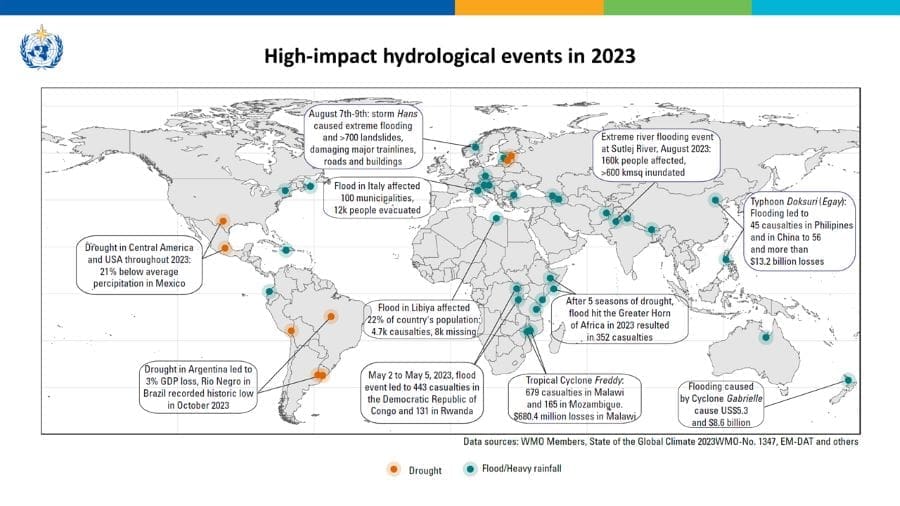The year 2023 marked a critical low point for global water resources, according to the World Meteorological Organization’s (WMO) latest State of Global Water Resources report. This comprehensive assessment highlights the worsening condition of the world’s freshwater systems, driven by escalating climate change impacts and rising global temperatures.
The WMO report reveals that 2023 was the driest year for global rivers in 33 years, a condition exacerbated by elevated temperatures, widespread droughts, and erratic precipitation patterns. This hydrological distress coincides with the largest mass loss of glaciers observed in five decades.
WMO Secretary-General Celeste Saulo underscored the severity of the situation, describing water as the “canary in the coalmine of climate change,” with increasingly erratic cycles of rainfall, flooding, and drought. These events are placing unprecedented stress on ecosystems, agriculture, and water supplies.
Global water supply under strain
The report illustrates how these conditions contribute to a growing scarcity of water. Over the past five years, river flows have consistently remained below normal, reducing reservoir levels and further straining water resources crucial for communities, agriculture, and ecosystems worldwide.
The year 2023 was characterized by severe drought in major basins, including the Mississippi in North America and the Amazon in South America, which reached record-low water levels. River basins in Asia, such as the Ganges and Mekong, experienced similarly diminished flows, pointing to a global trend of declining water availability.

This decline also reflects broader environmental stress. The transition from La Niña to El Niño conditions in mid-2023, coupled with a positive phase of the Indian Ocean Dipole (IOD), contributed to extreme weather events globally. In Africa, the hydrological challenges became tragically evident when floods in Libya led to the collapse of two dams in September 2023, claiming over 11,000 lives.
Glaciers suffered a particularly severe setback in 2023, losing over 600 Gigatonnes of water – the largest loss recorded in the past 50 years. This alarming trend has been observed across various regions, including Western North America, the European Alps, and New Zealand. In Switzerland, for example, glaciers have lost around 10% of their remaining volume over the past two years.
With the Northern Hemisphere experiencing reduced snow cover in recent years, particularly in late spring and summer, regions that rely on snowmelt for water supply face growing insecurity. According to the WMO, areas such as Europe, Scandinavia, the Caucasus, and Western Canada have already passed peak water – the maximum rate of glacier melt – reducing long-term water availability. Other regions, such as the Russian Arctic and Svalbard, continue to experience increasing rates of ice mass loss, signaling an uncertain future for water resources tied to glacial and snow reserves.
Global reservoirs showed inflow patterns that mirror river discharge trends, with significant deficits in regions such as India, North and South America, and parts of Australia. Notable exceptions included the Amazon and Parana basins, where inflows remained above normal. However, in these basins, river discharge levels were well below normal, pointing to complex dynamics influenced by both natural conditions and water management practices.

Groundwater resources also face pressures from both climatic and human factors. While regions such as South Africa, Australia, and Israel reported above-normal groundwater levels, long-term depletion continues to be a serious issue. North America and Europe, in particular, are experiencing declining groundwater levels due to prolonged droughts and over-extraction. Groundwater levels in Chile and Jordan remain low, largely due to unsustainable abstraction practices rather than climate-induced factors alone.
The report notes a concerning decline in soil moisture across North America, South America, North Africa, and the Middle East. Prolonged droughts have led to below-normal soil moisture levels, particularly from June through August, and affected agricultural productivity. Meanwhile, regions such as Alaska, northeast Canada, and parts of Russia experienced above-normal moisture levels due to an increase in rainfall. This erratic distribution of moisture further illustrates the unpredictability of the hydrological cycle under a warming climate.
Addressing the water crisis
The WMO’s report not only highlights the hydrological challenges but also points to a significant data gap. Despite advances in monitoring, many parts of Africa, South America, and Asia remain underrepresented in hydrological data collection.
The report calls for improved data sharing, cross-border collaboration, and robust monitoring systems. Secretary-General Saulo emphasized that “we cannot manage what we do not measure,” underscoring the need for better data to inform policy decisions and disaster risk management.
To enhance water-related hazard monitoring, the WMO is supporting initiatives like the global Early Warnings for All program, which aims to provide early warning systems by 2027. This program focuses on improving data quality and access, allowing for more effective responses to extreme hydrological events and water shortages. Additionally, the WMO’s Global Hydrological Status and Outlook System (HydroSOS) and the Hydrological Observing System (WHOS) aim to expand global datasets, facilitating comprehensive analysis of water resources.
With over 3.6 billion people facing inadequate access to water for at least one month each year, and this number projected to rise to more than 5 billion by 2050, the urgency for coordinated action is paramount. The WMO’s report warns that without immediate efforts to address water scarcity and better manage freshwater resources, achieving the United Nations Sustainable Development Goal on water and sanitation (SDG 6) will remain an increasingly distant goal.
Source: World Meteorological Organization (WMO)
Featured image credit: wirestock | Freepik




